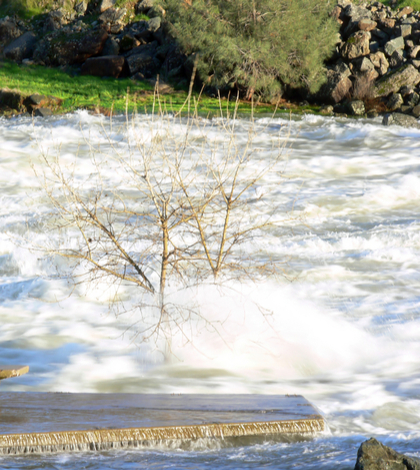The California Department of Water Resources (DWR) announced on Tuesday the likelihood of using the main Oroville spillway based on incoming storms between now and the first week of April. The main Oroville spillway was significantly damaged in the 2017 when one atmospheric storm after another pummeled northern California. Ultimately a crater measuring some 150 feet long, 450 feet wide and 30 feet deep occurred in the main spillway. When the main spillway was deemed unusable water began flowing over the concrete weir along the top of the emergency spillway, cascading onto the emergency spillway for the first time in the dam’s history. The erosion at the base of the weir progressed much faster than anticipated and the erosion of the emergency spillway threatened to undermine and collapse the concrete weir. Although that never occurred some 188,000 downstream residents were evacuated as a precaution of the potential disaster.
DWR and its contractors spent a year-and-a-half of tireless construction, often with crews working throughout the night, to repair the ravages of the 2016-17 Water Year (WY) at the Oroville Dam. They successfully met a Nov. 1, 2018 milestone in repairing the main spillway and have continued to work on the emergency spillway and other structures throughout the overall Oroville Dam system. DWR has indicated that the main spillway and the emergency spillway have been reconstructed and are now able to handle flows as needed to manage lake levels and provide flood protection for the surrounding communities.
With current Oroville Reservoir levels at approximately 845 feet, projected incoming storms in the next week have prompted DWR officials to closely monitor the reservoir levels and current forecasts as well as beginning its standard process of notifying regulatory agencies, local law enforcement and local elected officials of the anticipated use. According to The Weather Channel rain, of 50 percent likelihood or greater, is forecast in Oroville in five of the next 10 days.
In preparation, DWR has begun the process of removing heavy construction equipment used during construction and the temporary road below the spillway is also being removed to minimize water quality impacts.
Temporary cameras and lights have been situated alongside the spillway for observational purposes when water begins to flow down the spillway. Downstream monitoring is also in place to track water quality.
DWR will continue to update the public, media and local partners through emails, news releases and social media as the situation evolves in relationship to the local weather and the use of the spillways.
 California Water News Daily Your Source For Water News in California
California Water News Daily Your Source For Water News in California


